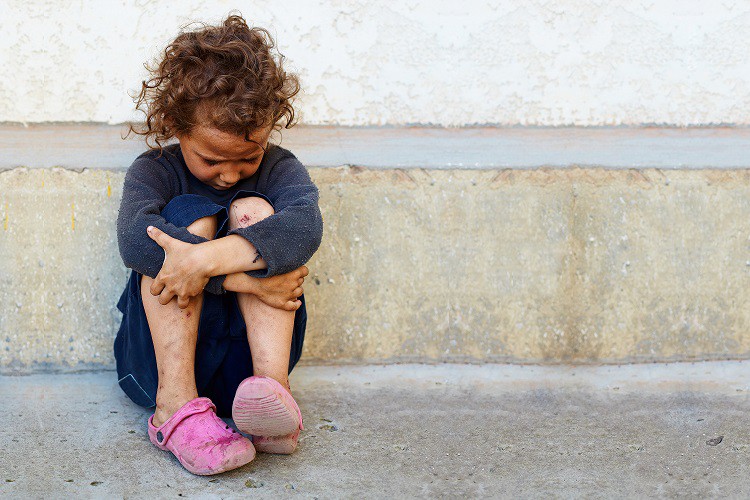Featured Image: Shutterstock/Olesia Bilkei
The number of street children in Egypt is rapidly rising, and the lack of awareness of this fact is also reaching its top. Children end up living on the streets due to many different reasons. Death of parents, poverty, domestic abuse or molestation are only a few reasons why so many children live on the streets. Sometimes, they get left on the streets by their own parents, who don’t want to carry their burden anymore.
Despite the fact that these children are victims of tough economic or social environments, they tend to find in the street an escape from the harsh, severe, and inhumane life they have been living. Of course these children easily fall prey to criminals who often train them to pickpocket, inhalant abuse (glue sniffing), or become sex-workers and that doesn’t include girls only.
“Despite the fact that these children are victims of tough economic or social environments, they tend to find in the street an escape from the harsh, severe, and inhumane life they have been living.”
Ashoka Arab World (AAW) is the regional branch of Ashoka: Innovators for the Public. Launched in 2003, AAW has identified and elected more than 60 of the leading social entrepreneurs in several Arab countries to become Ashoka Fellows. These social entrepreneurs work in various sectors, creating a difference for the benefit of the environment. They work in different fields such as housing, health, children, youth, civic engagement, gender parity, education, income generation and other sectors. Ashoka has prepared an event for the Collaborative Platform for Street Childrenin cooperation with eight organizations which provide shelter and care for street children in Egypt. The platform included organizations from Minya and Alexandria, such as Friends of Life Association, Bedayat (Beginnings) Institution, and Abnaa Masr Institution, along with the institutes located in Cairo.
The event consisted of three rounds of educational entertainment and awareness. The Arts Corner, of which children paint and draw. The second round was the Awareness Sessions for kids and another for teenagers. In the first round, children sit in a circle as the instructor tells a story, after the story each child is allowed to speak up and point out the lesson learned. The second session was for older ones, and it was about Health Awareness, the instructor begins to teach them the difference between the HIV virus and the AIDS, the children joined the discussion with either questions or suggestions and clarifications. The last round was Physical Education instructed by a professional coach who helped the children exercise, play soccer and more different activities.
“AbdelAziz was born and raised at Hope Village. He was brought there after his 14-year-old mother Amina, a rape victim, had given birth to him.”
I came across a six years old boy called Zizo (AbdelAziz), who was thrilled with the mug he won, and started telling me what he is planning to do with it, “I will make some tea for my mom”, and when asked where his mom is, he started stomping the floor in anger, “I want my mom, I want my mom!” AbdelAziz was born and raised at Hope Village. He was brought there after his 14-year-old mother Amina, a rape victim, had given birth to him. She was allowed to stay with him at Hope Village, where she found help and shelter. When Zizo was 6 he had to be separated from his mother as she started repulsing him for reminding her of her traumatic experience. “She will not be able to raise him, she is still a child”, says AbdelAziz’s helper, “she tried to escape several times, and she used to push him on the floor at other times. He is old enough to leave her for his own safety.”
My second encounter was with Amr, who came all the way from Minya, who was found in the garbage bin as a baby. “We hide the fact that they’re illegitimate children, we tell them their parents died in the earthquake, although there wasn’t an earthquake.”
“My second encounter was with Amr, who came all the way from Minya, who was found in the garbage bin as a baby.”
When interviewing Mrs. Iman Bibars, the regional director of Ashoka organization, the hardships of street children are disastrous, “There are no “Street Children”, they are Egypt’s children, they are victims of hard unbearable conditions that drove them to become sex-workers, to pick-pocket, shine-shoes and stand by the cars in parking lots”, she explains giving examples of many girls who had been raped and severely beaten by their own fathers,hence ran away to find a better life that turned to be even more bitter. “They run away for a glimpse of hope, but they find monsters, beasts eating up their raw flesh. Everyone they come across takes advantage of them”, she continues, “they shouldn’t be judged, they’re victims of a severe life, and this is the most important message I want to convey through this.”
We have to wake up and smell the coffee and do something about God’s forgotten children, before it is too late because we are all responsible.

